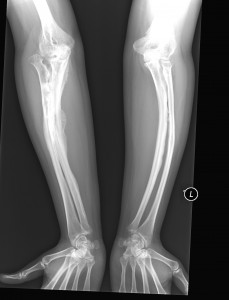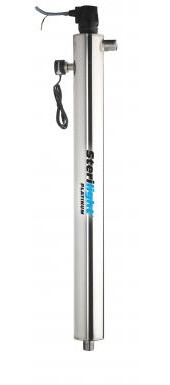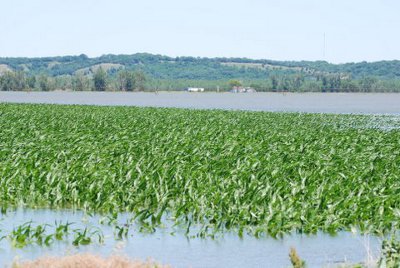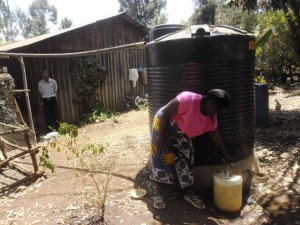Will Drinking Reverse Osmosis Water Turn Your Bones to Putty?
Come, Let Us Reason Together
by Gene Franks
Several years ago a leading Natural Hygienist and distiller merchant wrote an article praising the health benefits of low-mineral distilled water. He used as a negative example the spring water at Hot Springs, Arkansas, which, he said, was so high in calcium and other minerals that it clogged the arteries and joints of the the natives, causing severe arthritic crippling. He offered no evidence except his personal observation.
This caught my attention because I had been to Hot Springs several times and the native Arkansans seemed to me as supple of limb as people in Texas or California. They did not clank or creak or cry out in pain when they walked.
Then I read a short book by another health authority, also a distiller vendor, named Dr. B., who described a scientific experiment he did with goats. Dr. B. put out several bowls of water, all high in dissolved minerals except one. When some thirsty goats were brought to the area, they all went straight for the distilled water and ignored the high mineral spring water. Dr. B said that this proved natural creatures instinctively know that distilled water is best.
However, when I tried to replicate Dr. B’s experiment with my own lab animal, my dog Pu Ch’i, I found that she always drank from the bowl closest to her, whether is was low in minerals or high, whether it was clear or muddy, whether it was bottled water or tap.

Drinkers of reverse osmosis water often have bones that bend easily because of calcium deficiency. Photo Courtesy of Get Rich Marketing Corp.
When I started selling water filters in 1986 I was exposed to the opposite view. Those who sell filters, as opposed to distillers or reverse osmosis systems, take the view that minerals in water are not just good but necessary, and that drinking low mineral water not only fails to provide essential nutrients but actually leaches calcium from bones and organs. Filter sellers at the time, especially the MLMers, cited a popular book (now forgotten, even by me) which gave examples of populations who drank hard (calcium rich) water as having healthier hearts than those of people who lived in areas where the water was naturally soft (low in calcium).
Since that time the great mineral war has continued, usually fueled by one marketing program or another. The arguments have remained essentially the same over the years. The mineral war is fought mainly at MLM rallies and on commercial websites. Independent science has not been a big player.
On one side are vendors of distillers, reverse osmosis units, and, more recently, deionizing cartridges, backed by many alternative health experts, who advocate “pure” water, which is defined as water with very low “dissolved solids” (minerals); they view anything in the water other than pure H2O as sludge, an impediment to water’s main function as the body’s purifying solvent, and they blame high-mineral water for everything from arthritis to kidney stones. Many doctors appear to support this view by putting patients with kidney ailments on low-mineral reverse osmosis water.
The other side, more vocal, is comprised mainly of sellers of conventional drinking water filters and, more recently, the curious devices called “ionizers.” Their pitch focuses on the body’s need for minerals and they argue that low-mineral water actually removes (“leaches” is the favorite word) minerals from the body. With the arrival of “ionizers” to the market, the issue of pH has been added. Ionizer vendors preach that the body needs water that is sky- high in pH and alkalinity, and that low-pH reverse osmosis water is harmful.
My Take on All This
Since our company sells both reverse osmosis and conventional filters, we don’t have a dog in the fight. If someone asks my opinion, I give it, but we’re happy selling either a filter or an RO unit and we try to make the product’s ability to reduce known contaminants, not mineral content, the issue.
We do this because we believe that except in extreme cases (like sea water, which I don’t advise you to drink) the mineral content of water is not a big issue.
Consider that in some parts of the United States, the total dissolved solids (TDS) count in drinkable city water is 20 times that of other regions. Is there an ideal TDS? Is there a correlation between the health of the citizens and the TDS of the local water? The total solids count contains both calcium and sodium. Some natural water has almost no calcium, while some naturally hard water has almost no sodium. Does this matter?
If you live in a city in west Texas, the tap water you drink may have 500 ppm (parts per million) hardness (calcium and magnesium), but if you live in Bolivar, Texas, your tap water has 500 ppm sodium and virtually no hardness. Does this matter? My unscientific observation has been that people in Bolivar and people in Lubbock both do fine, as do people who live in northern California where the TDS of tap water may be 30 ppm with very little calcium or sodium. I spoke with a customer in Colorado this week whose natural TDS reading is 27. He has a reverse osmosis unit to protect against fluoride and arsenic that reduces the TDS to 2. Should he put a “remineralizing” device on his reverse osmosis unit to restore the water to its original TDS, although that TDS is less than 1/20 of the TDS of the natural water in many areas? Does the difference between 27 and 2 matter? Does the difference between 1000 and 50 (typical reverse osmosis reduction) matter?
The human body has evolved and learned to thrive on a planet whose water differs greatly in mineral content from place to place. When water is in the clouds it is distilled water—literally–because the earth’s recycling process is a giant water distiller. When the distilled water precipitates and falls to earth it picks up impurities from the atmosphere and becomes very much like reverse osmosis water in mineral makeup, having roughly the same Total Dissolved Solids count (around 10) as lake water that has been run through an undersink reverse osmosis unit in your kitchen. People who have rainwater collection systems to provide water for their homes have essentially the same water they would have if they pulled water from a well and processed it through a reverse osmosis unit.
Should we assume that drinking rainwater is unhealthy and that the only suitable drinking water is water that has filtered through dirt and rocks and picked up their impurities?
To me it seems obvious that the human body has exceptional ability to adapt to its environment. Just as we can adjust to cold climates and hot, we have a wide range of tolerance for food and water. If you drink water with 20 parts per million dissolved minerals or 400, the inner wisdom of your body will quickly adjust it to what it needs. When your body needs minerals, it takes them the easy way, from the organic minerals in foods. It does not waste its time trying crack open the inorganic minerals (rocks) dissolved in water unless no other minerals are to be had.
Although the pH issue raised by “ionizer” vendors doesn’t deserve an argument, I’ll make a single comment: Simply ask yourself–does it seem reasonable that the human body, which has evolved over eons and done extremely well drinking natural waters from a wide pH range, from very acidic to very alkaline, now in the the 21st century suddenly requires high pH water that can only be obtained from a $2,000 “ionizer?”








![pwanniemedium[1]](http://purewatergazette.net/blog/wp-content/uploads/2012/05/pwanniemedium1-246x300.jpg)
